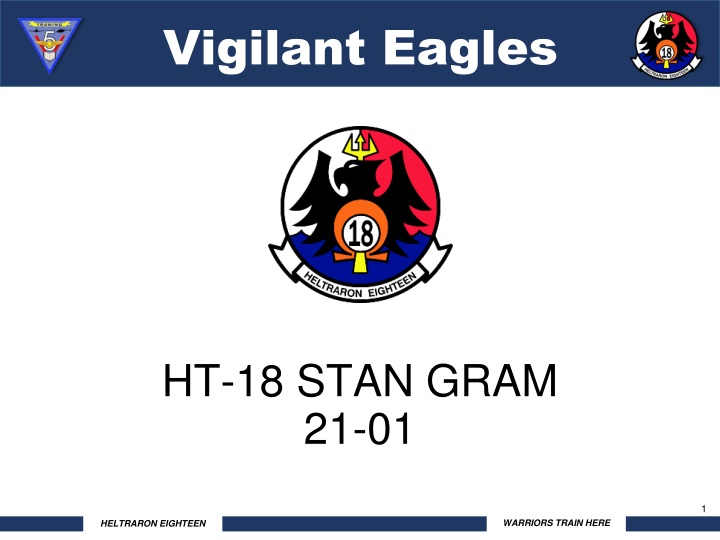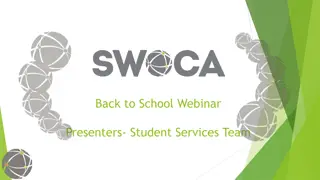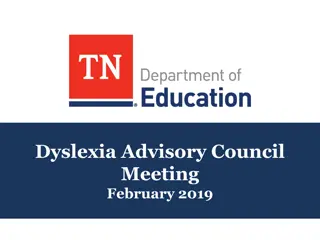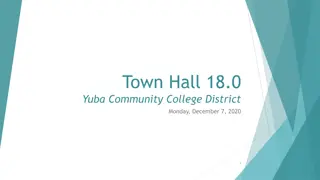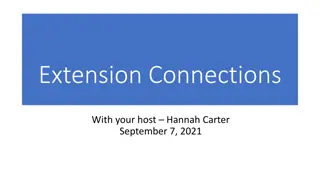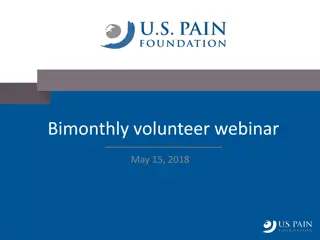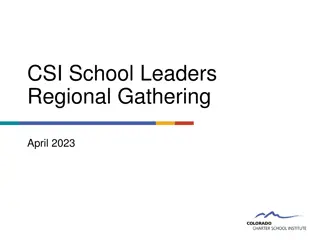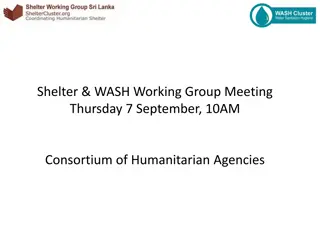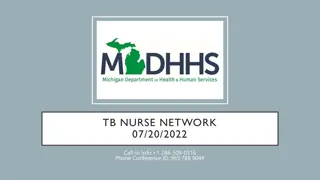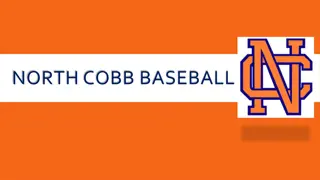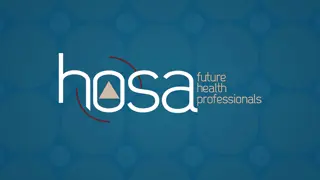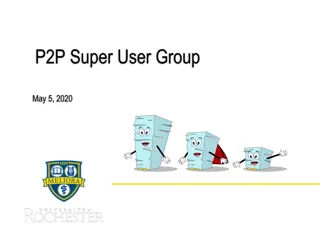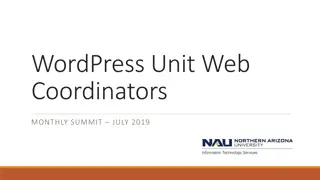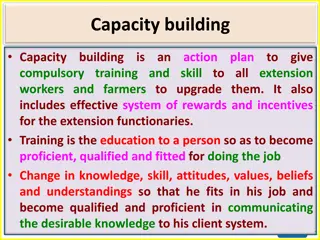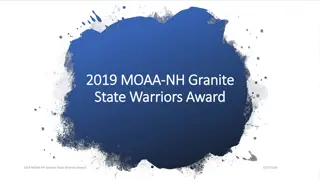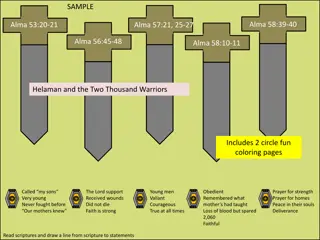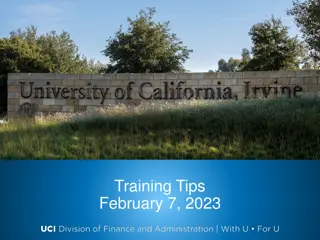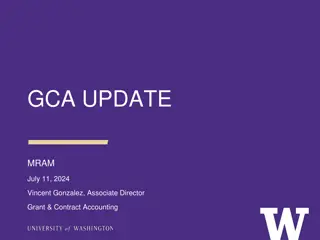Warriors Training at Heltraron Eighteen - Overview and Updates
Explore the training activities at Heltraron Eighteen, focusing on the vigilance and dedication of the Warriors. From historical heritage to current agenda, flying summaries, and call outs, get insights into the Stan upgrades, board results, end-of-year summary, and call outs leaderboard. Witness the commitment and growth of the Warriors as they strive for excellence.
Download Presentation

Please find below an Image/Link to download the presentation.
The content on the website is provided AS IS for your information and personal use only. It may not be sold, licensed, or shared on other websites without obtaining consent from the author.If you encounter any issues during the download, it is possible that the publisher has removed the file from their server.
You are allowed to download the files provided on this website for personal or commercial use, subject to the condition that they are used lawfully. All files are the property of their respective owners.
The content on the website is provided AS IS for your information and personal use only. It may not be sold, licensed, or shared on other websites without obtaining consent from the author.
E N D
Presentation Transcript
Vigilant Eagles HT-18 STAN GRAM 21-01 1 WARRIORS TRAIN HERE HELTRARON EIGHTEEN
Heritage PME Trident = Navy Spade = Death Red/Yellow = Vietnam The Seawolves flew over 120,000 combat sorties over South Vietnam and Cambodia. Over 200 Seawolves would be wounded in combat and 44 would be killed in action. Lion = Inspired by this German Beer. 1965: Navy helos used for ASW, SAR. Army conducted most offensive helo missions. 1. 1966: Vietnam. Navy established HC-1 to support Navy mission operating army gunships (UH-1) 2. 1967: HC-1 divided into 4 squadrons, to include one Light Attack squadron (HAL-3) AKA Seawolves. 3. Quick reaction force for Search and Destroy patrols, recon, MEDEVAC, and SEAL team insert/extract. 4. Success led to creation of HC-4, HSC-84, HC-5, combat participants in Iraq, Haiti, Bosnia, and Afghanistan. 2 WARRIORS TRAIN HERE HELTRARON EIGHTEEN
Agenda 1. Big Picture 2. Stan Board Results 3. End of Year Flying Summary / Call Out Leaderboard 4. Wing Stan Update 5. Stage Updates 6. Call Outs 3 WARRIORS TRAIN HERE HELTRARON EIGHTEEN
Big Picture Stan Upgrades: Need demonstrated flight time. Get those Xs! Call outs are significant. 1. QIP: Expect to fly annually with STAN IP, quarterly with any IP. SNIV to fly with a friend! 2. Back to Basics: Comm/Nav checklists, preflight, systems, etc. 3. 4. See Stage Leader to discuss your interest in a stage. The answer might not be no , but it might be not right now . 5. STAN owns Factoryhand-U. If you want something posted for availability, let us know. 4 WARRIORS TRAIN HERE HELTRARON EIGHTEEN
Stan Board Results 2020 Q1 STAN BOARD Approved following upgrades: Contact B Inst / Nav Form / SAR NVG Crysler O Connell Boniface Scarfo (X) Liebovich Murn Entrekin Lorenz Borneman Entrekin Evanski Feedback: 1. Selection is based on qualification (and limited to 35% per stage): Experience Build your flight time Gradesheets IAW instruction, meaningful, complete Student critiques See STAN binders for examples 2. Discuss your stage/STAN intentions with that stage leader. STAN shapes stage manning based on your desires and needs of the Squadron 5 WARRIORS TRAIN HERE HELTRARON EIGHTEEN
End of Year Summary IPs and X s flown (min 100 events) IPs must strive for 2 Xs a day! CY20: Median IP flew 205 X s. Half flew more, half flew less. 205 Xs X s FLOWN INSTRUCTOR Note: this does not correct for any other factors (PCS time, HITU completion, WX, leave, etc.) 6 WARRIORS TRAIN HERE HELTRARON EIGHTEEN
Call Outs Leaderboard For all IPs, the Average number of call outs 8. IP Call Outs Quals LT Sing 56 FORM / SAR STAN *IP OF THE YEAR!* LT Brown 27 INST STAN LT Borneman 27 INST STAN / SAR STAN LT Ellis 37 INST STAN Capt Harrington 34 INST STAN / FORM STAN LT Lorenz 24 INST STAN / FORM STAN Capt Murn 23 INST STAN LT Regis 20 BRAVO STAN Our most senior IPs are experienced and proven effective. Ask them for advice, tips, tricks, techniques. Schedule QIP before they depart! 7 WARRIORS TRAIN HERE HELTRARON EIGHTEEN
WING STAN Updates 1. SITE X / PACE Channel. Use the GTN Direct-to KNSE and do not cross back into KNSE airspace. 2. SITE X gravel runways. These will be approved for landings soon . 3. TW-5 iPads. Available for use. Get one if desired. Students are being issued these in primary. 4. New Comm/Nav selector panel coming. Stand by. 8 WARRIORS TRAIN HERE HELTRARON EIGHTEEN
Bravo Contact / Tactics Recent Critiques IPs have different expectations for the handling of EPs in the channel Expectation is that the SNA is able fly a simulated PEL and begin a wave off by 400 , to be complete by 300 and no slower than 50 knots, IAW RWOP. During the simulated PEL verbalizing lock, Talk, Squawk, PCL, and speaking to their profile choice. Pace On-wings, may use the Spencer channel. Use Pace channel with restriction. Do not skip channel work. . We would like more off-wing flights On-wings: sniv your students for both flights, coordinate with OPS to make this happen. A number of SNA s only went to Pace and Spencer for the C4500 block. Use Site X and Santa Rosa your primary C4500 field. Students unlikely to see their onwing field again. Set them up for success with exposure to their Contact-C fields. IP s are heavy on the controls Include this as a debrief point. Was I too much on the controls? Give context as necessary. Maintain solid defensive posturing. A firm back block (taco grip) is critical to avoid tail strikes. This allows more freedom of movement to less critical areas. Some IPs didn t like hearing over one, back on, up one Train for what work s for the student, not to the IP. It s a recommended verbal in the FTI and therefore completely fair training tool. 9 WARRIORS TRAIN HERE HELTRARON EIGHTEEN
Bravo Contact / Tactics Trends Poor muscle memory, mashing trim, floating elbows. We have been seeing floating elbows, abnormal hand position, and posture problems. On-wings: remember that during those C4000 block flights are critical to catch those bad tendencies. Ensure the student is in your scan. Check their ergonomics and positioning. Offwing flights should be used to double check/sanity check to the On-wing. Power checks SNAs are not comparing their simulated power against their hover TQ to decide on a landing type. One technique, to distinguish between the two: - Refer to the first power check as your in-flight power check , used to determine if flight may be continued. - Follow this with calling for PCL, Lock/Talk/Squawk - Then the landing power check to determine landing power/torque limit, etc. Drive home that we need flight leadership. The SNA needs to be making all calls, the decision to the field, and back. Eliminate the which way do you want to split, sir . Tell me what you re doing, why, then execute. The check ride IP will tell them what maneuver to execute but other than that, if not used, we will sit their quietly. Debrief maneuvers in the CRM context, using CRM terms (communicate to me ., lead me by ., etc) 10 WARRIORS TRAIN HERE HELTRARON EIGHTEEN
CONTACT B Call Outs LT Wofford: Patient and calm when instructing x2 LT Greiner: Effective at walking students through the pattern and approach calmly x3 LT Burgess: Effective at identifying weaknesses quickly correct x4 Capt Murn: Demo do technique is very effective x3 BRAVO TEAM: Keep the press! You are building the habit patterns that students will carry into the next block! 11 WARRIORS TRAIN HERE HELTRARON EIGHTEEN
Inst / Nav / Con-C Trends CONTACT - C Incomplete power checks. Students successfully executes compressor stall / underspeed EP and directs a sliding landing. BUT, fails to check power available for the landing. Ensure students complete a power check prior to landing, per the FTI. Single Engine Failure. Students anticipate a power off wave off at the expense of flying a good auto. Hold the student accountability. If you have not simulated a successful restart and directed a waveoff, they should fly a power recovery auto to the deck. Brief/debrief accordingly. INSTRUMENT Comm/Nav checklists. Hit or miss on proficiency. Students should execute a Comm/nav checklist on every RI/BI flight. If it s a hot seat, execute prior to take off (cycle the avionics master switch to reboot the GTN650). These are the reps they need for the checkride. Usually good procedural knowledge and cockpit setup for the approaches. Continue to be demanding with procedural compliance. Your instruction in the I4300/I4400 flights set students up for Checkride success. Inconsistent with ability to define when the aircraft is IMC per FAR/AIM and CNAF (see next slide) Report cancelling IFR . Students unsure what this means, limitations, etc. Make sure you discuss this in the RI block. ADB / Preflight knowledge dips after Contact B. Engage students and ask questions. On preflight, or shutdown if a hotseat. Walk early if needed to stay on schedule. ADB gouge is being loaded to FACTORYHAND-U. Instrument IPs: demand excellence with the basic procedures (6Ts, WRNTB, PASTGG, etc). These have carried students through their instrument check! 12 WARRIORS TRAIN HERE HELTRARON EIGHTEEN
Instrument Training You are only in one box at any given time. The VFR / IFR Table VFR IFR Normal. Normal. VMC (Contact Events, BI flights, practice approaches VFR) (RI flights) Normal IMC Be concerned. IMC isn t solely loss of visible horizon or in the clouds . (RI flights) Per FAR/AIM and CNAF: IMC conditions exist any time a visible horizon is not distinguishable. - Or Meteorological conditions expressed in terms of visibility, distance from clouds, and ceiling are less than the minima specified for VMC. Why is this important: Breaking VMC minima can place you into IMC conditions while VFR. Skirting weather mins on BI flights (for example) puts you at risk. If told to report cancelling IFR , you must be able to continue flight VFR, and thus be able to navigate to your destination while maintaining appropriate cloud clearances. 13 WARRIORS TRAIN HERE HELTRARON EIGHTEEN
Inst / Nav Feedback RI / BI / NAV Feedback: It would be very helpful to simulate the actual IFR environment if the Sim instructors used the radio traffic setting in the sim Expecting this change as part of the bridge syllabus. Appreciate IPs going through the full EP, from initial recognition to communicating intentions to ATC and landing as required. Refer to Chapter 5 of the FIG. Specifically, section 504 clarifies expectations for EPs in BI/RI flights. Student SHOULD know EP by this point. Now it s teaching them how to recover safely in IMC conditions. IPs distinguishing between procedure and technique and giving students room to developing their own sound techniques. Easy win. Continue to stress this. Night contacts would like to see more variability in the flights This student flew Peter Prince and the Hospital Route for both night contacts. LT Brown sent out several great scenarios to fly for a Night Contact. If you need ideas please see Stan; the Hospital Route is not a default flight plan. *STAN will push out the night profile contacts that we have on file. There are more engaging options than 2R4/Hospital Route. More CRM instruction by the Sim IPs Recurring feedback we are working with the CIs and have discussed standardized approaches to CRM. Helpful Instructional Techniques: Give the students the opportunity to fly as much as possible to include in and out of outlying airport/OLFs and taxiing around, even if it s coming back from a BI flight (and taxiing is not the emphasis per se). Emphasizing crew tasking during RI flights and how to task share between PAC and PNAC. 14 WARRIORS TRAIN HERE HELTRARON EIGHTEEN
Inst / Nav Call Outs LT Millis (x3): tough but fair; expectations = reality; great preparation for the fleet! LT Thomas (x2): Standardized the flight, good level of depth in the brief LTJG Cozby (x2) made discussed items applicable to the fleet LT Gordon (x2) very helpful EP discussions LT Cipko (x2) created a tough environment for LL flights; great learning tool XO - scenario-based LL Nav flights were the most fun flights in flight school LCDR Falce emphasized CRM in the instrument regime Easy win here: replicate! Snaps for XO! LCDR Donati great debrief and feedback Maj Entrekin genius GTN tips LT Regis great CCX profile LT Ellis Went into great detail on RI flights LT Scarfo Taught the fundamentals of RIs LT Brown also very helpful EP discussions Capt Harrington PAC/PNAC responsibilities during LL Nav Capt Murn great trim technique instruction Pouty: see STAN, we want these tips for the gouge! Students love fleet stories and fleet applicability. The BI scan will save their life! 15 WARRIORS TRAIN HERE HELTRARON EIGHTEEN
FORM / SAR Trends /Recognized Good Techniques Form class was good (x5) Consistent scheduling (X7) Thanks Ops Team! Continue to give in-depth critiques of the form brief especially for F4003/4101. Students appreciate the feed back when you can discuss why it is important for the fleet and future briefs. Students are really responding well to talking through the maneuvers while they are being executed. That being said, after an initial discussion allow them some time to figure out what corrections need to be made before stepping over them. (obviously do what you need to do to maintain safety of flight). Explaining that the contingencies we practice here, IIMC, lost comm, on-scene commander with a wingman,etc, actually carry over to the fleet and will apply these real world. (Students like fleet examples to put this into perspective). Letting the student s critique their own positions and correct them instead of hearing the IP tell them they re out of position constantly. 16 WARRIORS TRAIN HERE HELTRARON EIGHTEEN
FORM / SAR Call Outs LT Sing: (x6) Allowing students to make mistakes. Extremely helpful and calm. SAR (x1) *One of the best IPs I ve flown with!* LT Borneman: (x4) Talking through inputs needed, LT Lorenz: (x6) Excited to teach, Extremely helpful walkthrough, Very calm, Form Class Capt Harrington: (x3) Walking through sight picture and positioning. LT Ellis: (x3) Form Class, Excellent, Calm and helpful x 4 LT Millis: SAR (x2) relating the discussion to the fleet. LT Maguire: x 2 17 WARRIORS TRAIN HERE HELTRARON EIGHTEEN
NVG MORE NVG IPs NEEDED! A premium placed on fleet experience. NVG cadre is seeking to diversify its fleet experience! Minimum 75 HRS NVG time. Why NVGs? Here are a few reasons: Great people! Empty hallways in the squadron! Peaceful green skies! More proficient students closer to the end of the syllabus. Enjoyable flying and an opportunity to discuss and demonstrate fleet-level knowledge and experience. Stop by and see LT Evanski to join the Goggle Team! Winter Weather: FOG! Watch the temperature / dew point spread. Keep in this in mind when you get ATIS. Temp Dewpoint will typically close as the night goes on. Discuss with the student accordingly and help them form good weather analysis. Have a plan! FOG: Light winds <10 knots, especially from the south. Common in the winter months. - Stable air mass. - LLL Nights: harder to detect fog. Look for scintillation, more apparent halos, and reduced image quality in unlit areas. - Low fog at NDZ can develop QUICKLY. Communicate with other Ips, and remember the further into the night we get, the more likely radiation fog gets as the ground cools. Pick up IFR. Return early. Make sure your students are calling out Instrument Flight Checks prior to departure. Keep an eye out for these signs, and have a plan to file IFR back home if necessary! Also, SVFR RTB is an option at night! STAY VIGILANT! 18 WARRIORS TRAIN HERE HELTRARON EIGHTEEN
FOG PILOT CONFESSIONAL This is a long read, but absolutely relevant to the wx you will experience. Learn from another IPs experience bucket. BLUF: Fog can be very unpredictable at KNDZ. I had to deal with two fog-related events in the past two few days. One turned out to be more difficult than expected, and I want to share this experience with you. Weather may affect your course of action. Have always a backup plan, always aviate, navigate, and communicate, and keep your SA high. Every situation is different, and one solution does not fit them all. Site X: We had some patchy fog around the field, but after we departed to the South, for Pt. Snake. Fog disappeared. Visibility was still affected by haze, but it was pretty good, especially to the South. ATIS at the home field was calling VFR conditions, and we had no problems to follow course rules until Igor. While on course rules, we could see both North and South fields. As soon as we got to Igor, a wall of patchy fog with tops below us had formed between us and South field; however, we were still able to see RWY 23-05, and we continue inbound without losing contact with the RWY for a left downwind RWY 23. We had to descend and maneuver around the fog, but we had no issues in maintaining visual contact. As soon as we landed, the field went IMC. From STAN: What would you do if you lost visual contact? What if you were low fuel? How much fuel would an approach take? The next night we weren t so lucky. We were coming back from a green route event. During the flight, we had noticed that patchy fog and haze were present in the WOA, but weather conditions were still VFR. Navigation was conducted without any problems, and we were able to hit all the CPs. We recovered via Pt. Snake, ATIS at KNDZ was calling VFR, and RWY 23 was in used. The weather along course rules was VFR. At point Igor, we encountered a very similar situation than the night before. Fog between Igor and the field. The student was flying, and we had the RWY lights in sight. At Igor, we heard that another helicopter was taking off from RWY 23, for a Baker departure, and tower told us to report left downwind for RWY 23. After we passed, Igor student lost visual contact with the RWY, and soon after, I lost it too; however, I was visual with pad Alpha just north of RWY 23. We both were still visual with the other helicopter, but we had drifted north of its position. I took the controls and flew direct inbound to for pad Alpha trayeling to avoid entering the fog while maintaining visual with the other helicopter. Tower advised us that we were approaching the runway from the North and to turn South. I told the tower that we had lost visual with the RWY, that we had Pad Alpha insight, and that I was turning right and climbing. I started my turn on top of the Pad with the other traffic still visual. As soon as I started turning, we regained visual with RWY 23 and entered left downwind RWY 23. The other helicopter aborted the departure and came back for landing. (1 of 2) 19 WARRIORS TRAIN HERE HELTRARON EIGHTEEN
NVG CONFESSIONAL (contd) My mistake was to assume that we would not have lost visual with the RWY. This mistake was driven by Wed event when in similar weather conditions, we were able to maintain visual contact with the RWY and had no problem joining the left downwind RWY 32. But the next night when we lost visual with the RWY, could I have done something better or different other than keeping pad Alpha insight, and continuing inbound to the field? The first thing I could have done differently: turn South or West and climb as soon as the student lost visual contact with the RWY, re-evaluate the situation and plan differently we had plenty of gas. I did not choose this option because I was concerned about the other helicopter. If, during my turn and climb, I would have entered IIMC, I would have lost visual contact with it, and this possible situation did not appeal to me. We were too close, and for me, this option had a higher risk than keeping pad Alpha insight and proceed inbound to the field. If there was no other tight traffic, I might have opted for it. The second thing I could have done differently and better was to communicate my intentions immediately to the tower and let them know that I was proceeding inbound for Pad Alpha because we had lost visual with the RWY. By doing so, everyone would have known my intentions, and the tower would not be surprised to see my searchlight aiming at the Pad. My communications were delayed because I followed the most critical rule in aviation Aviate, Navigate, Communicate, in this exact order and priority. In this specific case, after we lost visual with the RWY, I took the controls and flew the airplane (Aviate), I continued inbound to Pad Alpha by keeping the Pad visual (Navigate). Lastly, I was ready to inform the tower that we had lost visual with the RWY. By the time I was ready to communicate my intentions, the tower had already told us about our position North of RWY 23. What is important here is that I had a solid situational awareness during the entire event. I know where I was, what was around me, and what I was going to do. However, I could have probably been faster with my communications, but things happened quickly. In conclusion, what I think I could have done better was: - I should not have assumed that I would not lose contact with the RWY. Every event, every flight, every night, is different. - I should have been faster in communicating my intentions to the tower. A quicker radio call to the tower would have allowed the tower to have had a better situational awareness of what was going on. (2 of 2) 20 WARRIORS TRAIN HERE HELTRARON EIGHTEEN
NVG Student Critiques All the goggle IP s had great techniques - made the syllabus enjoyable! Hardest working groups of IP s LCDR Loeb - ran a relaxed cockpit and pointed out NVG considerations throughout the flight. Great feedback. LT Evanski great input for approaches and sight picture. Great PME on briefing technique and presence Oncoming NVG Stage Manager! LT Evanski - should be the mandatory V4001 instructor. Excellent teacher LT Brown provided interesting flight scenario (V4004-4005) LT Scarfo Enthusiastic, knowledgeable and very informative. The hands-on portion was the best part. Emphasize more pre- flight instruction and repetitions Maj Entrekin explained using directive comms while navigating, and how to avoid an SA trap with too many (internal) comms LT Evanski and Maj Entrekin - both provide great instruction as well as confidence in the IP/HAC. Never felt unsafe and the events were fun. LL Nav: enjoyed prepping my own routes and flying low level. Emphasis on CRM w/ low level flying was apparent and was a lot of fun The V4003-4005 LL Nav are an opportunity to discuss/demonstrate next-level thinking and aircraft management. Use your fleet experience to introduce scenarios and the why behind how we do business. Students appreciate this! As always, emphasize CRM in the night environment Demo good PNAC BI callouts, cockpit management techniques and concise internal comms. Lots of great comments for our NVG Team. Keep up the good work and learn from each other! 21 WARRIORS TRAIN HERE HELTRARON EIGHTEEN
NVG Student Critiques For OPS: Lots of appreciative comments for consistent scheduling lately. Thanks OPS! Once again, multiple positive comments when NITE Lab is scheduled in very close proximity to the NVG Sim and Flights, and negative comments when it is not. No surprise here. Please keep doing your best to hold off on scheduling students for NITE Lab until as close as possible to NVGs. This practice allows: Circadian adaptation Morning NITE Lab, afternoon NVG sim, NVG flights. Good currency of information for better retention of NITE Lab material. Plus, this is how the Bridge Syllabus will do it. Keep it up OPS! Add LFF ers to the PUB the following night in case they are cancelled due to wx/mx. SNAs/IPs like the longer brief time schedule (3 hour gap) between brief and flight. This allows for good quality briefs and for crews to get dinner before walking to the aircraft. 22 WARRIORS TRAIN HERE HELTRARON EIGHTEEN
LAST SLIDE 1. When in doubt, there is no doubt. Adjust your profile / event, or cancel if wx is unsafe. 2. Get those hours and Xs to advance up! 3. Talk to STAN if you have feedback, concerns, questions, good ieas. 4. We re here to help you conduct quality instruction. 23 WARRIORS TRAIN HERE HELTRARON EIGHTEEN
